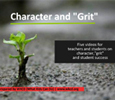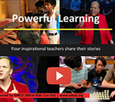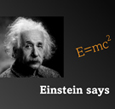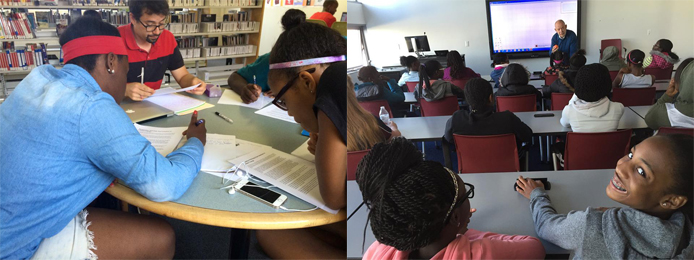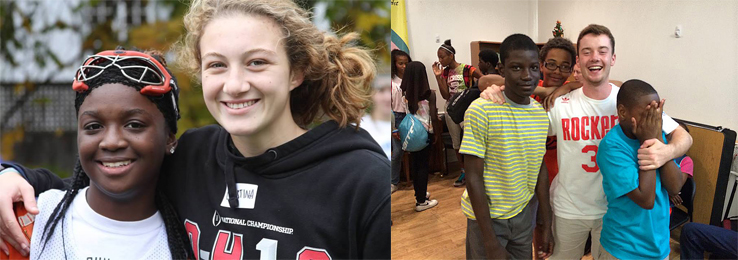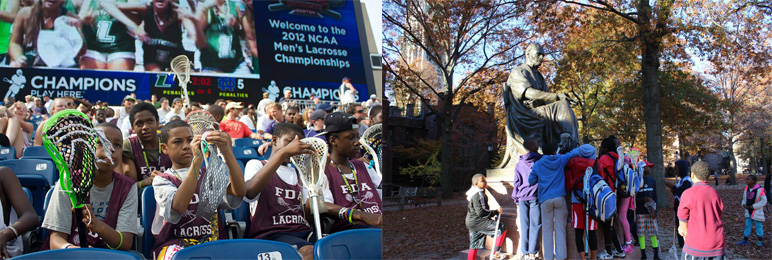OTHER WKCD WEBSITES SPECIAL COLLECTIONS Students as Allies in School Reform POPULAR WKCD PUBLICATIONS (PDFS] A Guide to Creating Teen-Adult Public Forums Cultural Conversations through Creative Writing Documenting Immigration Stories First Ask, Then Listen: How Your Students Can Help You Teach Them Better Making Writing Essential to Teen Lives Profiles of Politically Active Youth Queer Youth Advice for Educators The Schools We Need: Creating Small High Schools That Work for Us
WKCD VIDEO Growth Mindset and Five Videos for Teachers and Students on Powerful Learning: Four Inspirational Teachers Share Their Stories Tricks: Discussion
Starters for Students
About Pushing Past Fear
| Harlem Lacrosse: Lessons About Learning by BARBARA CERVONE |February 8, 2016
This profile of Harlem Lacrosse and Leadership is the first in a series of stories about some of the remarkable programs that are part of New York City’s Student Success Network—a rapidly growing, self-governing network of 40 youth development and education organizations committed to empowering NYC’s low-income middle-and high-school students with the social-emotional competencies to succeed in college and career. Jessica, a sixth grader at Harlem’s Sojourner Truth School, was in tears. Her English teacher had just refused to accept the essay she’d handed in the day before. The assignment had been to write something about herself, but instead she’d written something “creative”—“a story I made up,” she said. Seeking consolation, Jessica turned to an unlikely source: her twenty-something lacrosse coach, Alyssa Palomba. “Of course she got mad at you,” said Palomba, as she huddled with Jessica in a room stacked with lacrosse gear on the school’s third floor. “She told you to do A and you did B. That's like when I ask you to play attack and you play goalie instead.” Three months earlier, Jessica had agreed to give the Harlem Lacrosse and Leadership (HLL) program at Sojourner Truth a try. Unathletic and younger than the other girls on the team, she was skeptical she’d fit in. But the match between Jessica and Palomba—who had found her own stride through lacrosse when she was Jessica’s age—was instantaneous. When Jessica complained that there was nothing in her life to write about, Palomba pointed to the moment a few weeks ago when she’d made her first catch in competitive play.
When a newly confident Jessica left fifteen minutes later, Palomba sensed the small sixth grader had gained an inch in the classroom and on the field. Lacrosse as a starting point What’s lacrosse? “It has something to do with a stick and a ball,” a teenager shooting hoops near West 150th Street tells an interviewer. “I used to confuse it with Motocross,” says another. A contact sport played between two teams, lacrosse has long been the preserve of upper class, white, suburban communities far removed from urban neighborhoods like Harlem— though its roots lie with the Native American Iroquois. The sport’s complexion is changing, though, as socially minded college players bring lacrosse to their work with urban youth. Like most new teachers, Simon Cataldo struggled to engage his most academically and behaviorally challenged students at Frederick Douglass Academy (FDA) I in Harlem. Recalling the discipline and cohesion he’d gained from years on the lacrosse field, he gathered eleven students, ten lacrosse sticks, team uniforms, and put his proverbially unruly crew to work. The experiment didn’t yield any sports trophies but, by year’s end, Cataldo's players posted the highest scores on the state math test by special education students in the school’s history. When the Frederick Douglas Academy team grew to 35 students in 2011, Cataldo launched Harlem Lacrosse and Leadership. Today, the program enrolls over 300 middle school boys and girls at eight programs in New York and Baltimore, with additional programs in Boston (2016) and Philadelphia (2017) underway. Marginalized by race, class, and special needs, many HLL students, though only eleven- or twelve-years-old, already seem destined to fail. HLL’s staff—all veteran players themselves—aims to alter that trajectory. And it seems they have. Since 2011, the GPA improvement for HLL students has been five to ten points. The on-time middle school graduation rate is a hundred percent. Boarding school scholarship offers since 2011 top $10 million. One of the hidden blessings of transplanting lacrosse from the suburbs to the inner city is that everyone starts as a beginner. And unlike basketball—or baseball, football, or soccer—a young lacrosse player’s hero is not a “pro” who skipped college, but a collegiate student-athlete.
HLL students play lacrosse three to five times a week. But the program is about much more than a sport or a team. On and off the field, HLL adds value to student learning. The program directors at each school—typically one for girls and one for boys—triple as coaches, mentors, and tutors, providing for:
Social-emotional skills like problem solving, teamwork, growth mindset, and more are woven into HLL’s daily work with students. This year, HLL is piloting a social-emotional learning curriculum (during study halls) that addresses these skills explicitly. Developed by Kim Appelt, HLL’s Director of Curriculum Design, the units draw from well-regarded SEL curriculum created nationally, then adapted to the particularities of HLL. Students keep writer’s notebooks, where they are encouraged to get their “thoughts and feelings down, ask questions, make observations, explore topics, reflect and remember, scribble, sketch and draw, make lists, and write, write, write.” Each marking period, HLL students set goals for lacrosse and academics, as well as personal goals. They identify a small, medium, and large goal for each category, explaining why the goal is important to them and what it will take to achieve. They review their goals with their program director at the start and end of each marking period. Recently, HLL received funding from The Women’s Sports Foundation to implement a curriculum that addresses the particular needs of female students on the cusp of adolescence.
Motivating students deeply discouraged by failure can be a daunting challenge. Motivators are built into HLL’s DNA. Of the four positions in lacrosse, for example, midfield is the plum, and the position falls to those who have built the stamina to run up and down the field without slacking. “Playing midfield is a much bigger fitness motivator than speeches about the benefit of being fit,” says Palomba. Sitting in a study hall while classmates let loose at recess, as HLL students do, requires its own type of stamina. “But when the studying pays off in better grades, it seems a good trade. College could be the plum,” Palomba says. When HLL staff talks about the key to the program’s success, however, they point to the sturdy relationships staff builds with students. “The relationships we create with our students, whether it be as coaches, tutors, and mentors—and the investments parents and teachers see us making in their kids—wrap into one powerful message,” says James Addona, HLL’s executive director. “These kids matter and we’re there for them.” Adam Daroff, a senior program director at Sojourner Truth School, underscores the importance of being a calming, positive presence for students, most of all when they cross the line.
Being there means small gestures, too. Palomba explains: “Sometimes the gains arise by simply paying attention to the look on a kid’s face when they arrive at school that morning. You can tell they’re having a really bad day, so you give them a big hug, an instinct that flows from your relationship. It’s so small, but maybe it’s the hug that allows them to focus in class that day.” Accumulating moments, connecting the dots Along with the power of relationships, Addona, Daroff, and Palomba have come to appreciate what they call the “accumulation of moments.” “You can have a lesson that introduces the idea of growth mindset,” says Addona, “but it doesn’t compare to the power of a student’s hearing every day: ‘You can do better. You can learn this. You can do it.’"
As part of her training as an AmeriCorps Coach Across America Fellow, Palomba learned about the value of downtime with kids.
Patient repetition is another tool. “You say things to kids like a million times and you think that they absorb nothing,” notes Palomba, “and then you turn around and the kid is saying something like, ‘Early is on time. On time is late.’ You're like, ‘Thank god you listened to me! Finally!’” Given the many ways HLL staff interacts with students during the school day, the opportunities to crosswalk what happens on and off the field abound. Daroff explains:
Staff learning and reflection Alyssa Palomba’s exchange with a tearful Jessica—who had missed the mark on an essay for English but, with Palomba’s guidance, found a personal triumph to write about—is the kind of story HLL staff might analyze at one of their regular cross-site meetings, examining the turning points. When Adam Daroff agreed to take on Kelvin, a fifth-grader notorious for daily fights, he banked on his colleagues helping him figure out how to hold Kelvin accountable without triggering profanities and fists. “Though we’re in different schools, we see a lot of similar cases,” says Palomba. “When we meet, informally or formally, we always talk about them, learning from each other's mistakes and each other’s successes. We also talk to teachers, trying to better understand a student’s background and the approaches the teacher has tried.” “We use each other as resources,” Daroff adds. “It allows us to be better each time we encounter a situation, to be proactive instead of reactive.” HLL program directors also make a habit of reflection. When they agreed this year to pilot a social-emotional learning curriculum that hadn’t been tried before, they committed to unpacking what worked and didn’t (from mechanics to concepts), recording their reflections after each lesson and bringing them to the next monthly cross-site meeting. (They also confer weekly by phone.) They are administering mid- and end-of-year student surveys—the same survey all other SSN members are using—to see what students have gained and what needs fixing. They hope to refine and focus the curriculum so that it doesn’t duplicate lessons that are already intrinsic to HLL’s activities, with good effect. The staff also wants to make the curriculum more culturally responsive. Here, they are turning for advice from the “culturally-responsive pedagogy working group” within the larger Student Success Network.
On the lacrosse field, HLL teams play their hardest, keep close score, but don’t measure their accomplishments in terms of a “winning” season. Playing their hearts out is the goal. Off the field, accomplishment takes many shapes. It’s been months since Kelvin got into a fight, and his grades are up. Fifteen-year-old Tanya, a Sojourner Truth student who started HLL homeless, years behind academically, and chronically absent, now acts like a captain and seems ready to tackle high school. The first HLL graduates—who began as eighth grade special education students written off by most—have won admission to elite, private colleges from Haverford to the U.S. Military Academy at West Point. Private preparatory schools like Groton, Loomis Chaffee, and Peddie have awarded HLL students full academic scholarships. (HLL prepares students for their new schools by providing additional after-school tutoring after they are admitted and intensive academic enrichment camps during the summer.) For students like Jonell, the dynamic is simple: “I come to school everyday and practice because I can see my future coming closer and closer.”
What Kids Can Do, Inc. | info@whatkidscando.org | www.whatkidscando.org
|



